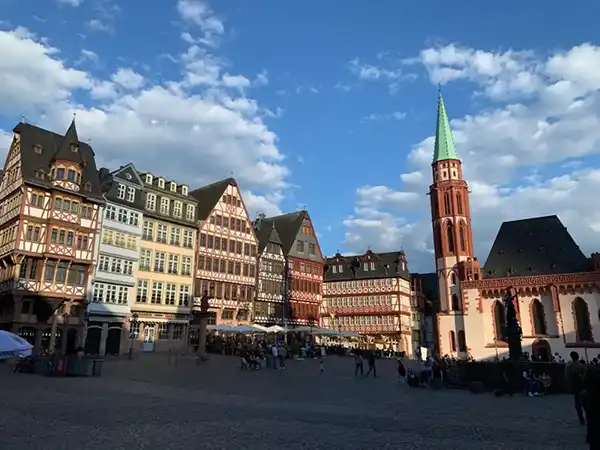Frankfurt: A Harmonious Blend of History, Modernity, and Culture
Nestled along the banks of the Main River, Frankfurt am Main is Germany’s financial powerhouse and a city where medieval charm collides with sleek modernity. Often dubbed “Mainhattan” for its skyscraper-studded skyline, this dynamic metropolis offers a rich tapestry of history, cutting-edge art, serene natural escapes, and culinary delights—all wrapped in a distinctly cosmopolitan vibe.
Historical Legacy: From Goethe to Gothic Splendor
Frankfurt’s roots stretch back over a millennium, and its historical narrative is etched into every cobblestone of the Römerberg (Roman Square). This iconic square, the heart of the reconstructed Old Town, is framed by half-timbered houses and the Römer, a trio of Gothic buildings that have served as the city’s town hall since 1405. Inside lies the Kaisersaal (Imperial Hall), adorned with portraits of 52 Holy Roman Emperors—a testament to Frankfurt’s role as a coronation site for centuries. Just steps away, the Frankfurt Cathedral (Kaiserdom) towers with its red sandstone facade. Climb its 328-step spiral staircase for panoramic views of the city, a reminder of how Frankfurt’s skyline has evolved from medieval spires to glass-and-steel giants like the European Central Bank.
Literature enthusiasts will find pilgrimage-worthy sites in the Goethe House, the birthplace of Johann Wolfgang von Goethe, Germany’s literary titan. Preserved with 18th-century furnishings, the house offers an intimate glimpse into the writer’s early life and creative spark. Meanwhile, the St. Paul’s Church stands as a symbol of democracy, hosting the first freely elected German parliament in 1848—a poignant stop for history buffs.
Modern Art and Cultural Innovation
Frankfurt’s cultural pulse beats strongest at the Museum für Moderne Kunst (MMK), a postmodern architectural marvel resembling a “slice of cake” near the cathedral. Its collection spans pop art, minimalism, and provocative installations, including Andy Warhol’s 100 Campbell’s Soup Cans and Joseph Beuys’ enigmatic Lightning with Stag in Its Glare. The museum’s rotating exhibitions ensure fresh dialogues between contemporary artists and global movements.
Art lovers should also explore the Museumsufer (Museum Embankment), a cluster of 38 museums along the Main River. Highlights include the Städel Museum, showcasing seven centuries of European art, and the Schirn Kunsthalle, known for avant-garde exhibitions. For a tactile experience, the Museum of Applied Arts displays exquisite design objects, from Baroque cabinets to Bauhaus furniture.
Natural Escapes: Rivers, Parks, and Prehistoric Wonders
Despite its urban energy, Frankfurt thrives with green spaces. The Main River Promenade is a lifeline for locals and visitors alike. Stroll or cycle along its banks, cross the Eiserner Steg (Iron Footbridge) for postcard views of the city’s contrasting skylines, or join a river cruise to unwind.
For a deeper dive into natural history, the Senckenberg Natural History Museum astonishes with its vast collections. Marvel at dinosaur skeletons, extinct species like the dodo, and the eerily preserved fossils of the Messel Pit—a UNESCO World Heritage site. The Palmengarten, a 54-acre botanical garden, offers lush greenhouses and themed gardens, perfect for a tranquil afternoon.
Culinary Delights: From Apfelwein to Gourmet Feasts
Frankfurt’s culinary scene mirrors its multicultural fabric. Begin with Apfelwein (apple wine), the region’s tart signature drink, best enjoyed in Sachsenhausen’s traditional taverns like Eisgrub-Bräu, where wooden barrels line the walls. Pair it with Handkäse mit Musik—a pungent cheese marinated in vinegar and onions—or Grüne Soße, a herb-based sauce served with boiled eggs and potatoes.
Meat lovers must try Frankfurter Rippchen, tender pork ribs with sauerkraut, or the city’s namesake Frankfurter Würstchen, a smoky sausage served with mustard and bread. For a modern twist, Freßgass (“Greedy Alley”) near the opera house teems with gourmet delis and Michelin-starred restaurants blending German traditions with global flavors.
Shopping: From Luxury Boutiques to Quirky Markets
Frankfurt caters to every shopper’s whim. The Zeil, Germany’s busiest shopping street, brims with international brands and department stores like Galeria Kaufhof. For luxury labels like Gucci and Patek Philippe, head to Goethestrasse, a tree-lined avenue rivaling Paris’ Champs-Élysées.
Yet the city’s charm lies in its eclectic markets. The Kleinmarkthalle indoor market lures foodies with artisanal cheeses, spices, and fresh pretzels. During December, the Römerberg Christmas Market transforms the square into a fairy-tale village, where twinkling lights, mulled wine, and handmade crafts evoke timeless magic.
Practical Tips for Explorers
- Transport: Frankfurt Airport (FRA) connects seamlessly to the city via S-Bahn (15 minutes to Hauptbahnhof). Use the Frankfurt Card for unlimited public transport and museum discounts.
- Safety: While generally safe, avoid the火车站area at night.

- Timing: Visit between May and October for festivals like the Museumsufer Night (August) and Book Fair (October).
Frankfurt is more than a financial hub—it’s a city where history whispers through rebuilt alleyways, art challenges conventions, and the Main River carries stories of resilience and reinvention. Whether you’re sipping apple wine by the water or gazing at Warhol’s soup cans, this German gem invites you to discover its many layers.